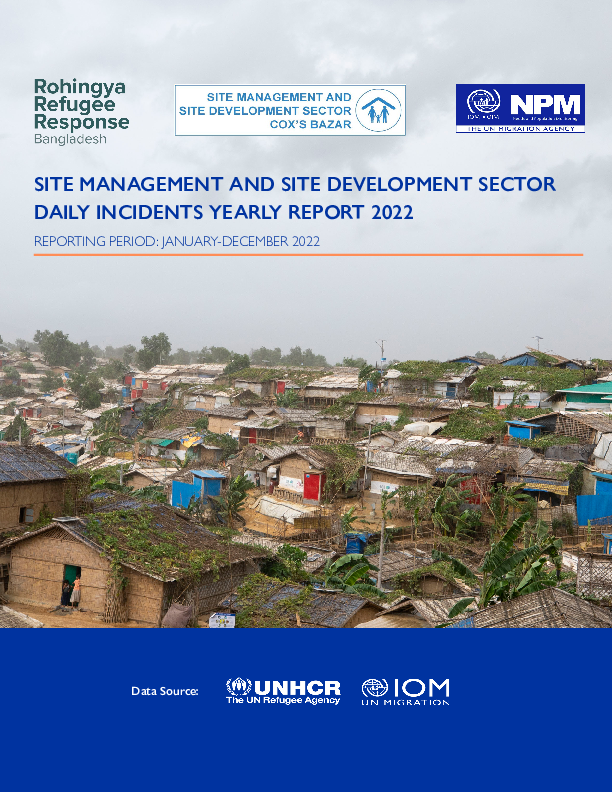-
Countries
-
Data and Analysis
-
Special Focus
-
Crisis Responses
Bangladesh — Site Management and Site Development Sector: Daily Incidents Yearly Report (January-December 2022)

Contact
NPM Bangladesh, npmbangladesh@iom.int
Language
English
Location
Bangladesh
Period Covered
Jan 01 2022
Dec 31 2022
Activity
- Other
Rohingya refugees live in the world’s largest refugee settlement in Bangladesh’s south-eastern district of Cox’s Bazar. The Myanmar military attack on Rakhine state in August 2017 forced thousands of Rohingya Muslims to escape to Bangladesh. Previous influxes were recorded in October 2016, when approximately 87,000 people crossed into Bangladesh, and other waves were registered during the previous decades. The total number of Rohingya refugees in Cox’s Bazar, including those residing in the district prior to August 2017 is estimated to be 960,5391 individuals. They live in difficult conditions, entirely depending on humanitarian aid. In the cramped conditions of camps besetting with other issues regarding accessing different services refugees’ torments rise during the cyclone and monsoon seasons every year because the population is concentrated in extremely congested sites within Ukhiya and Teknaf Upazilas of Cox’s Bazar district which is well-known to be vulnerable due to annual monsoon and cyclone seasons. Most of the shelters where the refugees live are made of tarpaulin sheets and bamboo in areas that are either hilly or low-lying.
The combination of densely populated sites and unsustainable shelter material exposes the refugee population to serious risks associated with heavy rains and high winds, such as flooding and landslides. To support the Rohingya refugee response during the cyclone and monsoon seasons the Site Management Site Development Sector (SMSD) Daily Incident Report (formerly known as the SM Category 1 Daily Incident Report) was established in May 2018. This system was developed by the SMSD Sector in coordination with the Inter Sector Coordination Group (ISCG), IOM, and UNHCR. Through this assessment, Site Management Support (SMS) Agencies systematically collect information across all camps in Cox’s Bazar affected by small and large-scale weather-related and man-made incidents. The incidents captured through this mechanism refer to small or large-scale localized events (such as landslides, floods, windstorms, heavy rain and fire) that cause minor to severe, even complete damage and have little to no impact outside of the locally affected area. In case of Level 2 or 3 events2 , of larger scope, the ISCG would trigger a JNA. The purpose of the system is to track any daily incidents across all camps, and their impact on the affected population.
Overall, the SMSD Incident Reporting is aimed at:
• Collect the initial information on the damages and displacement caused by small and large-scale weather-related and man-made incidents across all the camps on a daily basis. • Report the initial information for immediate action.
• Provide a comprehensive overview by producing reports and datasets on a Daily & Weekly basis to convey key information on the impact and damages caused by weather-related and man-made incidents across the camps.
• Support a timely and adequate Rohingya refugee response throughout the year, particularly during the cyclone and monsoon seasons.
